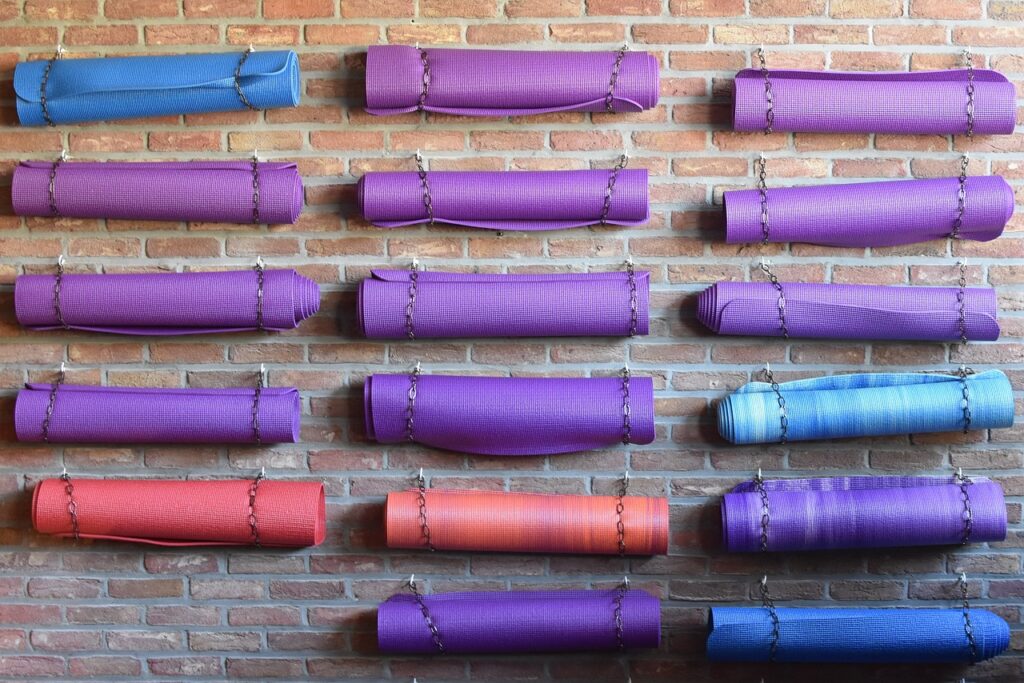
Introduction
Yoga mats have become an essential tool for practitioners, offering a comfortable and stable foundation for their practice. Understanding the significance of choosing the right yoga mat is crucial to ensuring a fulfilling and enjoyable experience on the mat. Let’s delve into the history of yoga mats, the importance of selecting the perfect one, and their undeniable benefits to your yoga exercises.
A brief history of yoga mats:
They have come a long way since their inception. Traditionally, yoga was practiced on various natural surfaces such as grass, animal skin, or wooden floors. However, the modern yoga mat was born with the rapid advancement in technology and the evolving needs of yogis.
It was in the mid-20th century that the development of yoga mats began, made primarily from cut-up carpet padding or rugs. These early mats served their purpose but lacked the cushioning and grip required for a fulfilling yoga practice.
The significance of choosing the right yoga mat for your practice:
Choosing the right yoga mat goes beyond mere aesthetics. It directly impacts your comfort, stability, and overall experience on the mat. A well-suited yoga mat can enhance your practice by providing support, insulation, and grip for various poses and movements.
It lets you fully immerse yourself in the practice without distractions or discomfort. Conversely, a poorly chosen mat may hinder your progress, leading to slippage, inadequate cushioning, and an unsatisfying session on the mat.
The benefits of using a yoga mat during exercises:
Using a yoga mat offers a multitude of benefits that contribute to a more rewarding practice. First and foremost, a good yoga mat provides cushioning to protect your joints and bones from the hard ground, allowing you to flow through your practice comfortably.
Yoga mats offer stability and grip, preventing accidental slips and ensuring proper alignment throughout your poses. They create a dedicated space for your practice, mentally preparing you for your mindful journey on the mat.

Different Yoga Mats
The yoga mat market offers various options for yogis’ diverse needs and preferences. Let’s explore some of the most popular types of yoga mats available today:
PVC Mats:
Comfort and durability in a synthetic material: PVC mats have long been a favorite among yoga practitioners due to their exceptional durability and cushioning. Made from a synthetic material called polyvinyl chloride, PVC mats provide excellent support for joints and are resistant to wear and tear. They are also easy to clean and maintain, making them a practical choice for yogis of all levels.
Natural Rubber Mats:
Eco-friendly option with excellent grip: Natural rubber mats are an excellent choice for environmentally conscious practitioners seeking a sustainable option. Sourced from rubber trees, these mats are biodegradable and offer fantastic grip, even during sweaty sessions. Natural rubber mats are also known for their cushioning properties, providing a comfortable practice while keeping the planet in mind.
Jute Mats:
Sustainable and non-toxic, perfect for hot yoga: Jute mats are ideal for eco-conscious yogis who prioritize sustainability and non-toxicity. Made from natural jute fibers, these mats are environmentally friendly and provide a firm grip, making them perfect for heated practices such as hot yoga. Jute mats also have excellent moisture absorption properties, keeping your practice comfortable and slip-free.
Cork Mats:
Renewable, antimicrobial, and provides excellent stability: Cork mats have gained popularity among yogis for their sustainable and unique properties. Harvested from the bark of cork oak trees, these mats are renewable and eco-friendly. Cork mats offer exceptional stability, preventing slips and slides during challenging poses. Additionally, cork is naturally antimicrobial, ensuring a clean and hygienic practice surface.
Travel Mats:
Lightweight and portable options for yogis on the go: Travel mats provide the perfect solution for yogis constantly moving. These mats are designed to be lightweight and compact, allowing for easy portability without compromising on quality. Whether practicing in a studio or outdoors, travel mats offer the convenience and comfort you need on your yoga journey.

Considerations Before Buying a Yoga Mat
Choosing the ideal yoga mat requires careful consideration of specific factors that align with your unique practice. Here are some essential considerations to keep in mind when selecting your perfect yoga mat:
Thickness
Finding the ideal balance between cushioning and stability: The thickness of a yoga mat plays a crucial role in determining the level of cushioning and stability it provides. Thicker mats offer more cushioning for sensitive joints, ensuring comfort during prolonged poses and flowing movements. On the other hand, thinner mats allow for a closer connection to the ground, allowing for better balance and stability during challenging poses. Finding the perfect thickness for your practice will depend on your specific needs and preferences.
Texture
Enhanced grip and comfort during different yoga styles: The texture of a yoga mat directly affects its grip and feel. Mats with a textured surface provide enhanced grip, preventing slips and maintaining stability throughout your practice. Additionally, the texture can contribute to overall comfort, allowing your body to stay grounded and connected during various yoga styles, such as Hatha or Vinyasa.
Size
Determining the appropriate dimensions to suit your practice: Selecting the right size of yoga mat ensures ample space for your practice without feeling restricted or uncomfortable. Standard yoga mats are typically 68-72 inches long and 24-26 inches wide. However, taller individuals may require longer mats, while those who prefer additional room for movement might opt for wider mats. Consider your body size and specific practice needs when choosing the appropriate dimensions.
Eco-Friendliness
Choosing mats made from sustainable materials: For practitioners who prioritize environmental sustainability, opting for yoga mats made from eco-friendly materials is essential. Look for mats from renewable sources such as natural rubber, jute, or cork. These materials lessen your environmental impact and provide excellent performance and durability.
Price Range
Assessing affordability in relation to quality: Determining your budget and evaluating the price range of yoga mats is crucial to finding the right balance between affordability and quality. While high-end mats may offer advanced features and superior durability, budget-friendly options provide adequate performance for beginners or occasional practitioners. Consider your financial circumstances and investment in your yoga practice when deciding on a price range.
Exploring Mat Cushioning and Density
The cushioning and density of a yoga mat directly influence comfort, support, and stability. Understanding the options available allows you to select a mat that complements your practice style. Let’s explore various mat options based on cushioning and density:
Standard Thickness: An overview of average mat thickness for various practices: Standard yoga mats typically range from 1/8 to 1/4 inch thick, balancing cushioning and stability. These mats suit yoga styles, including Hatha, Vinyasa, and Ashtanga. The thickness provides adequate support for joints and allows for a comfortable practice without compromising stability.
Extra-Thick Mats:
Ideal for sensitive joints and restorative yoga: Extra-thick mats offer enhanced cushioning and greater comfort for practitioners with sensitive joints or those who practice restorative yoga. These mats range from 1/4 to 1/2 inch thick, providing optimal support during reclining poses and gentle movements. Extra-thick mats are designed to alleviate pressure on the knees, hips, and other sensitive areas, allowing for a more relaxed and rejuvenating practice.
Dense Mats:
Supportive for more challenging poses and advanced yogis: Dense mats, usually made from high-density foam, provide excellent stability and support for advanced yoga poses that require more balance and strength. These mats are generally thinner, ranging from 1/16 to 1/8 inch, allowing for a closer connection to the ground. The dense material facilitates improved balance and control during challenging poses, making them a preferred choice for experienced yogis.
Thin Mats:
Portable and convenient for those who prefer close contact with the floor: Thin mats, typically around 1/16 inch thick, offer a minimalistic approach to practicing yoga. Ideal for traveling yogis or those who prefer a closer connection to the floor, these mats provide a lightweight and portable option. While they offer less cushioning, thin mats are stable, allowing practitioners to maintain a firm foundation during various yoga styles, such as Kundalini or Yin.
Grip and Traction:
Maintaining stability and preventing slippage during yoga practice is essential for safety and optimal performance. The grip and traction offered by your yoga mat play a pivotal role in achieving this goal.
Let’s explore different options for finding stability on your mat:
Sticky Mats:
Enhanced grip for sweaty practices: Sticky mats, often made from PVC material, offer improved grip, especially during practices that induce excessive perspiration. These mats have a tacky surface that helps prevent slippage, allowing yogis to flow through sequences without interruption gracefully. Sticky mats are trendy for styles such as Bikram or hot yoga, where high temperatures increase sweating.
Open-Cell vs. Closed-Cell Mats:
Understanding the differences and advantages: Yoga mats can be categorized into open-cell or closed-cell mats based on their cell structure. Open-cell mats have tiny pores that absorb moisture, providing excellent grip even in sweaty conditions. On the other hand, closed-cell mats have a sealed surface that repels water, making them easier to clean and more hygienic. Both options offer advantages; it’s a matter of personal preference and specific practice needs.
Textured Mats:
Extra traction for easily maintaining poses: Textured mats feature patterns or raised surfaces, providing additional traction for a secure grip. These mats are particularly beneficial for poses that require greater stability, such as standing balances or inversions. The texture helps to anchor your hands and feet, minimizing the risk of slipping and allowing for a more confident practice.
Moisture-Wicking Mats:
Efficient grip for hot yoga and intense workouts: Moisture-wicking mats, often made from absorbent materials like natural rubber or cork, draw sweat away from the surface. This feature ensures a firm grip during hot yoga sessions or intense workouts, where sweat accumulation may compromise stability. Moisture-wicking mats dry your practice surface, allowing you to focus on your breath and movement without distractions.
Durability and Longevity
Investing in a durable and long-lasting yoga mat ensures a consistent practice experience. Here are some factors to consider when assessing the durability and longevity of your mat:
High-Quality Materials:
Choosing mats that withstand wear and tear: Opting for mats made from high-quality materials, such as natural rubber or PVC, significantly enhances their durability. These materials are designed to withstand constant use, resisting wear and tear over time. Additionally, they are less prone to cracking or flaking, ensuring a long-lasting investment in your yoga practice.
Reinforced Edges:
Preventing fraying and extending mat lifespan: Mats with reinforced edges offer enhanced durability, preventing fraying and potential damage along the edges. These reinforced borders keep the mat intact, even with frequent use and intensive movements. Investing in a mat with reinforced edges ensures a prolonged lifespan, allowing you to focus on your practice instead of worrying about premature wear and tear.
Cleaning and Maintenance:
Proper care to ensure your mat lasts longer: Adopting a regular cleaning and maintenance routine improves the lifespan of your yoga mat. Most mats can be cleaned using a mild soap or a mat-specific cleaning spray. It’s vital to follow the manufacturer’s instructions for cleaning and drying to prevent any damage or deterioration. Properly cared-for mats stay in optimal condition, serving you well for years.
Hygiene and Safety
Maintaining proper hygiene and safety during yoga is vital for your well-being. Consider the following factors when selecting a mat:
Antimicrobial Mats:
Preventing the growth of bacteria and odors: Antimicrobial mats are specially designed to inhibit the growth of bacteria and prevent unpleasant odors. These mats are beneficial if you practice in shared spaces or engage in hot yoga, where sweat accumulation can facilitate bacterial growth. An antimicrobial mat ensures a clean and odor-free practice surface, promoting a hygienic environment.
Closed-Cell Mats:
Resisting sweat absorption for a more hygienic use: Closed-cell mats, as mentioned earlier, have a sealed surface that does not absorb moisture. This feature significantly reduces the risk of bacteria and odor buildup on the mat. Closed-cell mats are particularly suitable for practitioners who sweat profusely or require easy cleaning for hygiene.
Non-Toxic Certifications:
Ensuring your mat is free from harmful chemicals: To safeguard your health and well-being, opt for yoga mats that have non-toxic certifications. Certifications such as OEKO-TEX® or PVC-free labels guarantee the mat is free from harmful substances like phthalates or heavy metals. Using a non-toxic mat ensures a safe and healthy practice environment.
Design and Aesthetics
Your yoga mat can be more than just a practical tool; it can also reflect your personality and style. Consider the following design features when selecting your mat:
Printed Mats:
Expressing your unique personality and style: Printed mats offer various design options, allowing you to express your creativity and individuality. From vibrant patterns to inspiring quotes, these mats contribute to a visually engaging and uplifting practice environment. Choose a design that resonates with you and sparks joy during your yoga sessions.
Alignment Lines:
Assisting with posture and alignment during practice: Some mats feature alignment lines or markings that help you maintain proper posture and alignment throughout your practice. These lines act as visual aids, assisting you in aligning the different parts of your body. Alignment mats are particularly valuable for beginners or individuals who want to refine their alignment.
Embossed Patterns:
Combining functionality with beautiful designs: Embossed pattern mats offer a unique combination of functionality and beauty. These mats feature raised motifs or textures that enhance grip and traction while adding an artistic element to your practice. Embrace the synergy of aesthetics and performance with an embossed pattern mat.
Yoga Mats for Specific Needs
Different yoga practices and individual preferences call for specialized mats. Consider the following options to meet your specific needs:
Hot Yoga Mats:
Sweat-resistant and slip-proof for high-temperature practices: Hot yoga mats withstand high temperatures and excessive sweating. These mats offer superior grip, ensuring stability and preventing slips during intense hot yoga sessions. With moisture-wicking properties and excellent traction, hot yoga mats keep you safe and focused throughout your practice.
Extra-Wide Mats:
Providing ample space for comfortable movement: Extra-wide mats are ideal for those who prefer additional space and freedom of movement during their practice. These mats offer broader dimensions than standard mats, providing plenty of room for stretching, sprawling, and exploring varying poses. Extra-wide mats cater to practitioners who prioritize spaciousness and ease in their sessions.
Travel-Friendly Mats:
Lightweight and foldable options for yogis on the move: Travel-friendly mats are designed for yogis constantly on the go. These mats prioritize portability by offering lightweight and foldable options. They are easy to pack into suitcases or bags, making them convenient companions for travel, outdoor yoga sessions, or gym visits. Travel-friendly mats ensure that you can maintain your practice wherever you go.
Eco-Conscious Mats:
Sustainable choices for environmentally aware practitioners: Various environmentally friendly options are available for eco-minded practitioners—mats made from.
Conclusion
Frequently Asked Questions
Q1. What is the ideal thickness for a yoga mat?
A1. The ideal thickness for a yoga mat typically ranges between 1/8 inch (3.175 mm) and 1/4 inch (6.35 mm). Thicker mats offer more cushioning for joint support, while thinner ones provide better stability for balancing poses.
Q2. Can I use a regular exercise mat for yoga?
A2. While it is possible to use a regular exercise mat for yoga, it may provide a different level of comfort and grip required for certain yoga poses. Yoga-specific mats are designed with materials and textures that enhance the practice.
Q3. How often should I clean my yoga mat?
A3. It is recommended to clean your yoga mat after every few uses, especially if you practice regularly. You can use a gentle mat cleaner or a mixture of water and vinegar to keep it fresh and bacteria-free.
Q4. Are natural rubber mats suitable for people with latex allergies?
A4. Natural rubber mats may not be suitable for people with latex allergies, as natural rubber contains latex proteins. However, some yoga mats are made from synthetic rubber or other latex-free materials and may be a better option for those with allergies.
Q5. Can I use a yoga towel instead of a mat for hot yoga?
A5. Yes, you can use a yoga towel instead of a mat for hot yoga. Yoga towels are designed to absorb sweat and provide a non-slip surface, enhancing grip during hot and sweaty sessions. However, some practitioners prefer using a yoga towel and a mat together for comfort and support.
Q6. Can I practice yoga without a mat?
A6. Yes, you can practice yoga without a mat, especially on a soft and non-slippery surface. However, a yoga mat offers stability, cushioning, and hygiene during your practice, so it is generally recommended to use one.
Q7. How long should a yoga mat last before replacing it?
A7. The lifespan of a yoga mat depends on its quality, frequency of use, and care. On average, a good-quality yoga mat can last anywhere from one to five years. Signs of wear, loss of cushioning, or decreased grip indicate it’s time to consider replacing your mat for optimal practice.
Share via:

